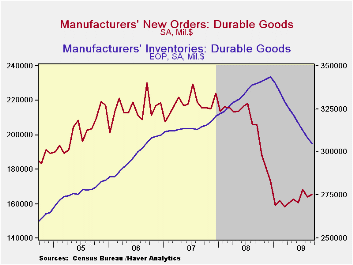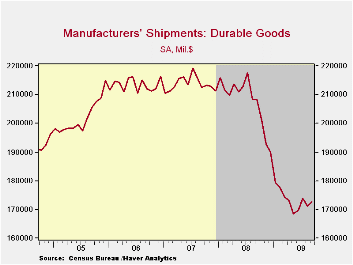 Global| Oct 28 2009
Global| Oct 28 2009U.S. Durable Goods Orders Rise, Continuing Firm Uptrend
by:Tom Moeller
|in:Economy in Brief
Summary
The manufacturing sector's recovery appears intact. Durable goods orders recovered an expected 1.0% last month following declines during two of the prior three months. Moreover, the three-month rate of increase held at a firm 12.6% [...]

The manufacturing sector's recovery appears intact. Durable goods orders recovered an expected 1.0% last month following declines during two of the prior three months. Moreover, the three-month rate of increase held at a firm 12.6% (AR). That increase followed a 51% rate of decline through last December. Since January orders have risen 4.1%.
Transportation equipment orders rose 1.1% last month, held back by a 0.1% (-24.1% y/y) downtick in motor vehicle & parts orders and a 2.1% (-51.3% y/y) decline in nondefense aircraft orders. Excluding the volatile transportation equipment sector orders show clear improvement. With a 0.9% rise last month, orders have risen 3.3% from their January low and have increased at a 5.9% rate during the last three months.
Higher orders for primary metals have led the improvement in durables bookings. The 0.3% increase last month followed strong gains during the prior three months and the three-month rate of increase rose to 24.5%. Orders for fabricated metals also have been quite strong. Following this strength is the electrical equipment sector. Though orders fell during the last two months, the three-month rate of increase held at a firm 6.5%. Also showing improvement has been orders for computers & related equipment. The weak 0.4% rise last month failed to make up large declines during the prior two months, but since their April low, orders have risen 9.6%.
The capital goods sector also has improved. New orders for nondefense capital goods rose 2.5% and they rose 2.0% excluding aircraft & parts. These latest increases build on strength developed this summer and orders have risen 8.1% from the April low.
Shipments of durable goods are now reflecting the improvement in orders. With a 0.8% rise last month, the three-month rate of increase improved to 6.6% and shipments are now 2.4% higher than the May low. The improvement has been paced by gains in shipments of metals but the machinery and electrical equipment sectors continue to lag.
Inventories of durable manufactured goods continued lower and posted a 1.0% decline which was the ninth consecutive monthly drop totaling 11.2%. The shedding of inventory has been broad-based led by a 21.0% decline this year in the metals area, a 20.5% drop in computer inventories, a 16.2% drop in motor vehicles and an 11.9% in electrical equipment.
The durable goods figures are available in Haver's USECON database.
| NAICS Classification (%) | September | August | July | Y/Y | 2008 | 2007 | 2006 |
|---|---|---|---|---|---|---|---|
| Durable Goods Orders | 1.0 | -2.6 | 4.8 | -19.6 | -5.8 | 1.4 | 6.2 |
| Excluding Transportation | 0.9 | -0.4 | 0.9 | -16.9 | -1.2 | -0.3 | 9.1 |
| Nondefense Capital Goods | 2.5 | -7.7 | 7.0 | -21.0 | -6.8 | 3.5 | 9.4 |
| Excluding Aircraft | 2.0 | -0.8 | -1.3 | -16.6 | -0.3 | -2.7 | 10.7 |
Tom Moeller
AuthorMore in Author Profile »Prior to joining Haver Analytics in 2000, Mr. Moeller worked as the Economist at Chancellor Capital Management from 1985 to 1999. There, he developed comprehensive economic forecasts and interpreted economic data for equity and fixed income portfolio managers. Also at Chancellor, Mr. Moeller worked as an equity analyst and was responsible for researching and rating companies in the economically sensitive automobile and housing industries for investment in Chancellor’s equity portfolio. Prior to joining Chancellor, Mr. Moeller was an Economist at Citibank from 1979 to 1984. He also analyzed pricing behavior in the metals industry for the Council on Wage and Price Stability in Washington, D.C. In 1999, Mr. Moeller received the award for most accurate forecast from the Forecasters' Club of New York. From 1990 to 1992 he was President of the New York Association for Business Economists. Mr. Moeller earned an M.B.A. in Finance from Fordham University, where he graduated in 1987. He holds a Bachelor of Arts in Economics from George Washington University.






